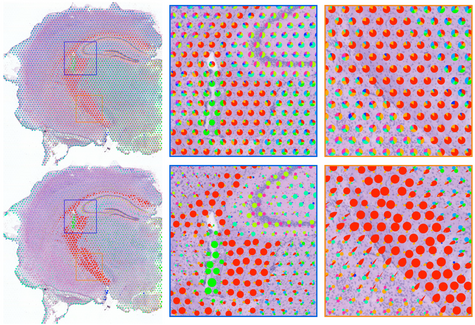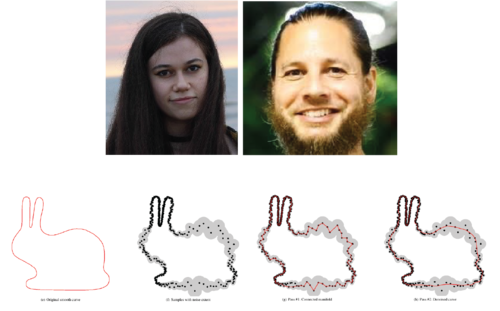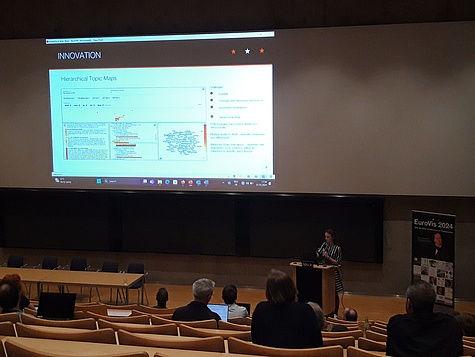Best Thesis Award - Julian Rakuschek

Open Reassembly @ Buch Wien Messe und Festival

Our Open Reassembly project was featured at this year‘s Buch Wien festival as part of the Science Lounge program.

The event took place from November 20th to 24th and featured a wide range of activities, including book presentations, author interviews, panel discussions, and workshops, fostering a vibrant exchange of ideas within the literary community. This year, a focus was on citizen science – a perfect fit for Open Reassembly.

In our Open Reassembly project, we approach the complex task of reassembling archaeological artifacts as a collaborative
process, where many participants work alongside computational methods to achieve successful reassembly. Several school
classes visited us during the exhibition to test their puzzle-solving skills.
For more information about Buch Wien and Open Reassembly,
visit
https://www.buchwien.at/programm/mitforschen-gaming-4-science/


Best Challenge Entry Award - Bio+MedVis Challenge @ IEEE VIS 2024, 13.10.2024
Our submission to the Bio+MedVis Challenge Track of the IEEE VIS, titled "Droplets: A Marker Design for visually enhancing Local Cluster Association", was well received and awarded "Best Challenge Entry" in the category Novelty.
Unfortunately, the workshop was switched from an on-site event to virtual-only, due to the recent landfall of hurricane Milton close to the intended conference venue in Tampa Bay. As a consequence, the poster presentation was changed to a short online presentation, which was streamed live.
We are proud and grateful for all the positive feedback and look forward to continue working on this promising concept.


Best Paper Award - Peter Houska - Eurographics Workshop 2024, 16.-18.09.2024


Our paper submission “Computer-Assisted Collaborative Fragment Matching of Incomplete Stone Artifacts” to the 22nd Eurographics Workshop on Graphics and Cultural Heritage (GCH 2024), which took place in Darmstadt (Germany) September 16th - 18th, 2024, was awarded the Best Paper Award.
The award was a 3D print of the fossil of a prehistoric horse found at the Messel Fossil Site. The fossil was digitized by the first autonomous scanning robot that delivers precise, color accurate scans in repeatable, high quality. The robot was developed by Fraunhofer IGD.
We are proud and grateful for this special, limited edition “trophy”!
For more info about the fossil and the digitization process with the 3D scanning robot, please visit:
https://www.igd.fraunhofer.de/en/media-center/press-releases/autonomous-high-quality-3d-scans-without-manual-postprocessing.html
We would like to thank our colleagues from the Department of Classics, University of Graz, for the scientific collaboration, the museum Schloss Bruck (Lienz) for providing stone fragments for this project, and the province of Styria for funding our research project (ABT12-603763/2022):
https://www.wissenschaft.steiermark.at/
CVA-Meeting 2024 Title Image, 11.10.24

We are proud to announce that our painted pottery unwrapping method “Direct Elastic Unrollings of Painted Pottery Surfaces from Sparse Image Sets”, published at the 19th Eurographics Workshop on Graphics and Cultural Heritage (GCH 2021), which took place at Bournemouth University (United Kingdom) from November 4th - 6th, 2021, was used to produce the title image of this year’s Austrian CVA Meeting.
The unrolled, distortion-minimized holistic view of the entire painted vase surface was created from 4 standard photogaphs of the vase.
ACM UMAP 2024, 01.07.2024
Our latest research on "Interaction Visualization for Analysing and Improving User Models" was presented by Stefan Lengauer at the 32nd International Conference on User Modeling, Adaptation, and Personalization (ACM UMAP 2024), held at the University of Cagliari, from July 1st till July 4th.
The work, which is part of the A+CHIS project, was among the 18 accepted entries of a total of 47 submissions to the Late-Breaking Results and Demos track.
The novel approach, which allows expert users to analyse, validate, and even improve upon user models was well-received and lead to several fruitful discussions.
Presentation at CGI'24, 01-05.07.2024
We congratulate the authors Irena Ruprecht, Florian Michelic, Eva Eggeling and Reinhold Preiner for presenting there paper titled "Adaptive Movement Behavior for Real-Time Crowd Simulation" on the CGI'24 on July 01. - 05., 2024.
This paper introduces a new method for modeling adaptice movement in real-time crowd simulations. It efficiently combines global path planning and local collision avoidance to improve performance and agent behavior. The approach uses a direction-aware approach for selecting relevant neigbor agents and blends goal-oriented and avoidance strategies. It integrates seamlessly with existing simulation techniques and enhances both performance and control over agent movement.
Presentation at CGI'24,

We sucessfullly got the opportunity to share our paper titled "InceptCurves: Curve Reconstruction Using an Inception" with an international audience of experts and parctitioners, at the CGI'24 on July 01-.05. 2024. Congratulation to the authors Saeedeh Barzegar Khalilsaraei, Alexander Komar, Jianmin Zheng and Ursula Augsdörfer.
InceptCurves is an inception-layered deep neural network structure, capable of learning simultaneously the number of control points and their positions in order to reconstruct the curve.
Presentations at WSCG 2024
Three very different and interesting CGV papers were presented at WSCG 2024. Congratulations to all students who presented!
- Gamillscheg, F., Ruprecht, I., Settgast, V., Pietroszek, K., Augsdörfer, U.: Brain Computer Interfacing with a Virtual Environment
- Komar, A., Kammerer, M., Barzegar Khalilsaraei, S., Augsdörfer, U.: LatEd: A Geometric Latent Vector Editor
- Komar, A., Riegler, M., Preiner, R., Augsdörfer, U.: Genetic Subdivision Curve and Surface Reconstruction
Congratulations to all authors !
CGV visitor – 29. May 2024

We had a visit from the vice-rector Stefan Vorbach at the CGV, who brought a little token of appreciation for Ursula Augsdörfer to say thank you for her engagement as dean of study of the faculty CSBME. Although time consuming, Ursula Augsdörfer enjoyed her time working together with colleagues and the vice-rectorate to improve various processes related to the studies at our faculty.
As can be seen on the photo, Ursula Augsdörfer was happy about the food package vice-rector Stefan Vorbach presented her with.
CGV Guest Speakers – 28. May 2024
It was nice to welcome Stefan Ohrhallinger and Diana Marin from TU Wien, who presented their work on curve and surface reconstruction at our institute on the 28th of May. Mr. Ohrhallinger is working on curve and surface reconstruction for the last 13 years, while Mrs. Marin has been working on topics related to computer graphics since her Master at Leeds University and focused on curve reconstruction during hr PhD. It was an interesting talk with many insights, which was following up by a lively research discussion with some good food.
EuroVis Workshop on Visual Analytics on May 27, 2024
We congratulate PhD student Mariia Tytarenko on her first conference presentation at the 15th International EuroVis Workshop on Visual Analytics on May 27 in Odense, Denmark. The research paper "Hierarchical Topic Maps for Visual Exploration and Comparison of Documents"
constitutes a novel approach for topic-based document exploration, inspired by a tilebar metaphor.
Presentation at the 15th International EuroVis Workshop
We congratulate PhD student Mariia Tytarenko on her first conference presentation ah the 15th International EuroVis Workshop on Visual Analytics on May 27 in Odense, Denmark. The research paper "Hierachical Topic Maps for Visual Exploration and Comparision of Documents" constitutes a novel approach for topic-based document exploration, inspired by a tilebar metaphor.
PhD awarded to Simon Kloiber
We congratulate Simon Kloiber to the successful defense of his PhD thesis titled "Data in Motion - Immersive Analytics of Spatio-Temporal Data in Virtual Reality" on April 26, 2024. The image (left) shows Prof. Bernhard Aichernig (dean of studies and head of examination committee, TU Graz), Simon Kloiber, and Prof. Tobias Schreck (advisor, TU Graz). Visible in the image top right is TT-Prof. Tiare Feuchtner (University of Konstanz) who served as external reviewer and examiner. Simon's PhD research was conducted within the FFG project VR4CPPS and follow-up projects.









